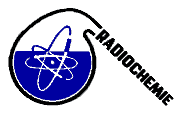Speaker
Dr
Radojko Jacimovic
(Jozef Stefan Institute, Ljubljana, Slovenia)
Description
Various trace elements in different types of iron based geological reference materials [JSS 804-1 (hematite), JSS 820-2 (limonite), SU-1 and SU-1a (iron-nickel-copper-cobalt ores)] were investigated using k0-NAA in both forms: instrumental (k0-INAA) and radioanalytical (k0-RNAA).
To avoid the interference of iron as a matrix element, firstly mineral was dissolved in aqua regia then liquid-liquid extraction procedure by diisopropyl ether (DIPE) in hydrochloric acid media was applied. Trace elements were determined using k0-INAA after irradiation of water phase. Secondly, the mineral was irradiated and than radiochemical extraction of Fe were done using DIPE and trace elements were determined by k0-RNAA in water phase.
The k0-NAA method, applied to determine the content of the investigated elements, after removal of Fe enabled to follow the distribution of 39 elements through their corresponding intermediate/medium and long half-lived radionuclides. The elimination of the matrix element lowered the detection limit for some trace elements compared to their corresponding values determined by k0-INAA in powder form and with certified values for some elements. However, the results for some elements (e.g. As, Ba, Ca, Cs, Hf, K, Na, Zn and Zr) are higher comparing to k0-INAA in powder due to the adsorption/desorption on glassware. The k0-RNAA procedure shows better agreement than k0-INAA with data obtained by k0-INAA in powder mostly due to negligible blank contribution. The results of this work will be presented and discussed.
Primary author
Dr
Radojko Jacimovic
(Jozef Stefan Institute, Ljubljana, Slovenia)
Co-authors
Ms
Milena Taseska
(Institute of Chemistry, SS. Cyril and Methodius University, P.O.Box 162, Skopje Macedonia)
Dr
Petre Makreski
(Institute of Chemistry, SS. Cyril and Methodius University, P.O.Box 162, Skopje Macedonia)
Prof.
Trajce Stafilov
(Institute of Chemistry, SS. Cyril and Methodius University, P.O.Box 162, Skopje Macedonia)
Prof.
Vekoslava Stibilj
(Jozef Stefan Institute, Ljubljana, Slovenia)

